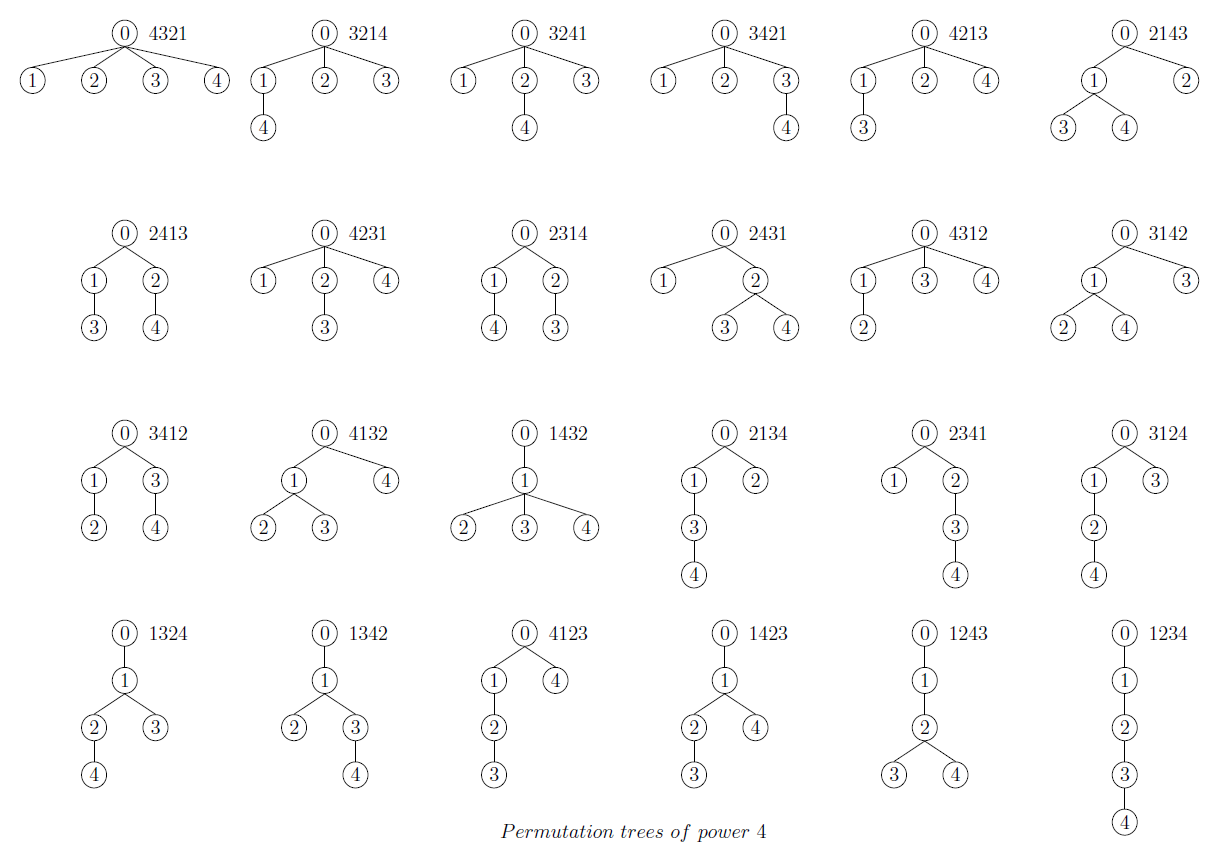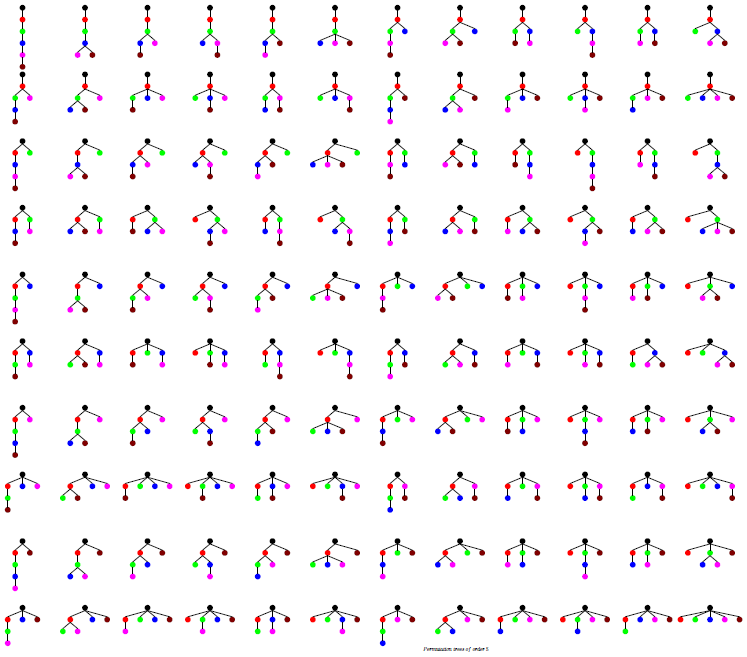Permutation Trees
Peter Luschny, 2010-07-20
Contents * 1 Permutation Trees o 1.1 Definitions o 1.2 Example classifications * 2 Permutation trees with power 4 * 3 Counting permutation trees o 3.1 A008292 Permutation trees of power n and width k. o 3.2 A179454 Permutation trees of power n and height k. o 3.3 A179455 Permutation trees of power n and height does not exceed k. o 3.4 A179456 Permutation trees of power n and height at least k. o 3.5 A179457 Permutation trees of power n and width does not exceed k. * 4 The correspondence: Permutation <-> Tree o 4.1 Given a permutation, how to construct the associated rooted tree? o 4.2 Given a rooted tree, how to construct the associated permutation? * 5 Flattening the tree: the caterpillar notation. * 6 Summary: Three classifications of permutation trees. * 7 The permutation trees with power 5
Definitions
A permutation tree is a labeled rooted tree that has vertex set {0,1,2,..,n} and root 0, and in which each child is larger than its parent and the children are in ascending order from the left to the right. The power of a permutation tree is the number of descendants of the root. The height of a permutation tree is the number of descendants of the root on the longest chain starting at the root and ending at a leaf. The width of a permutation tree is the number of leafs.
The correspondence with the permutation is given by traversing the periphery of the tree starting at the right hand side of the root and recording a node whenever the node's right edge is passed.
For example below the tree A has height 4 and width 1, the trees B, C, D all have height 3 and width 2, ..., and tree I has height 1 and width 4.

Example classifications
Permutations classified by height and by width of the associated rooted tree. Trees are coded as parental lists.
| Permutations and trees, n = 3. | |||||||||||||||||||||||||||||||
|
|
||||||||||||||||||||||||||||||
| Permutations and trees, n = 4. | |||||||||||||||||||||||||||||||||||||||||||||||||
|
|
||||||||||||||||||||||||||||||||||||||||||||||||

A008292,
Permutation trees of power n and width k.
(Eulerian numbers).
| n\k | 1 | 2 | 3 | 4 | 5 | 6 | 7 | 8 | 9 |
|---|---|---|---|---|---|---|---|---|---|
| 1 | 1 | ||||||||
| 2 | 1 | 1 | |||||||
| 3 | 1 | 4 | 1 | ||||||
| 4 | 1 | 11 | 11 | 1 | |||||
| 5 | 1 | 26 | 66 | 26 | 1 | ||||
| 6 | 1 | 57 | 302 | 302 | 57 | 1 | |||
| 7 | 1 | 120 | 1191 | 2416 | 1191 | 120 | 1 | ||
| 8 | 1 | 247 | 4293 | 15619 | 15619 | 4293 | 247 | 1 | |
| 9 | 1 | 502 | 14608 | 88234 | 156190 | 88234 | 14608 | 502 | 1 |
A special case: A008292(n,2) = A000295(n) for n > 1.
A179454,
Permutation trees of power n and height k.
| n\k | 1 | 2 | 3 | 4 | 5 | 6 | 7 | 8 | 9 |
|---|---|---|---|---|---|---|---|---|---|
| 1 | 1 | ||||||||
| 2 | 1 | 1 | |||||||
| 3 | 1 | 4 | 1 | ||||||
| 4 | 1 | 14 | 8 | 1 | |||||
| 5 | 1 | 51 | 54 | 13 | 1 | ||||
| 6 | 1 | 202 | 365 | 132 | 19 | 1 | |||
| 7 | 1 | 876 | 2582 | 1289 | 265 | 26 | 1 | ||
| 8 | 1 | 4139 | 19404 | 12859 | 3409 | 473 | 34 | 1 | |
| 9 | 1 | 21146 | 155703 | 134001 | 43540 | 7666 | 779 | 43 | 1 |
Special cases: A179454(n,2) = BellNumber(n) - 1 = A058692(n)
for n > 1;
A179454(n,n-1) = A034856(n) for n > 1.
A179455, Permutation trees of power n and height does not exceed k. (Partial row sums of A179454.)
| n\k | 1 | 2 | 3 | 4 | 5 | 6 | 7 | 8 | 9 |
|---|---|---|---|---|---|---|---|---|---|
| 1 | 1 | ||||||||
| 2 | 1 | 2 | |||||||
| 3 | 1 | 5 | 6 | ||||||
| 4 | 1 | 15 | 23 | 24 | |||||
| 5 | 1 | 52 | 106 | 119 | 120 | ||||
| 6 | 1 | 203 | 568 | 700 | 719 | 720 | |||
| 7 | 1 | 877 | 3459 | 4748 | 5013 | 5039 | 5040 | ||
| 8 | 1 | 4140 | 23544 | 36403 | 39812 | 40285 | 40319 | 40320 | |
| 9 | 1 | 21147 | 176850 | 310851 | 354391 | 362057 | 362836 | 362879 | 362880 |
Special cases: A179455(n, 2) = BellNumber(n) = A000110(n) for n > 1; A179455(n, n-1) = A033312(n) for n > 1.
A179456, Permutation trees of power n and height at most n-k. (Partial row sums of A179454 starting from the diagonal.)
| n\k | 1 | 2 | 3 | 4 | 5 | 6 | 7 | 8 | 9 |
|---|---|---|---|---|---|---|---|---|---|
| 1 | 1 | ||||||||
| 2 | 2 | 1 | |||||||
| 3 | 6 | 5 | 1 | ||||||
| 4 | 24 | 23 | 9 | 1 | |||||
| 5 | 120 | 119 | 68 | 14 | 1 | ||||
| 6 | 720 | 719 | 517 | 152 | 20 | 1 | |||
| 7 | 5040 | 5039 | 4163 | 1581 | 292 | 27 | 1 | ||
| 8 | 40320 | 40319 | 36180 | 16776 | 3917 | 508 | 35 | 1 | |
| 9 | 362880 | 362879 | 341733 | 186030 | 52029 | 8489 | 823 | 44 | 1 |
A special case: A179456(n, n-1) = A000096(n).
A179457, Permutation trees of power n and width does not exceed k. (Partial row sums of A008292.)
| n\k | 1 | 2 | 3 | 4 | 5 | 6 | 7 | 8 | 9 |
|---|---|---|---|---|---|---|---|---|---|
| 1 | 1 | ||||||||
| 2 | 1 | 2 | |||||||
| 3 | 1 | 5 | 6 | ||||||
| 4 | 1 | 12 | 23 | 24 | |||||
| 5 | 1 | 27 | 93 | 119 | 120 | ||||
| 6 | 1 | 58 | 360 | 662 | 719 | 720 | |||
| 7 | 1 | 121 | 1312 | 3728 | 4919 | 5039 | 5040 | ||
| 8 | 1 | 248 | 4541 | 20160 | 35779 | 40072 | 40319 | 40320 | |
| 9 | 1 | 503 | 15111 | 103345 | 259535 | 347769 | 362377 | 362879 | 362880 |
A special case: A179457(n, 2) = A000325(n) for n > 1 (Grassmannian permutations).
Given a permutation, how to construct the associated rooted tree? Maple version.

An example use is:
tree2parent := proc(tree,n)
local j, k, parent, branch;
parent := array(1..n);
for j from 1 to nops(tree) do
branch := tree[j];
for k from 2 to nops(branch) do
parent[branch[k]] := branch[k-1];
od;
od:
convert(parent, list) end:
ListPermTrees := proc(n) local i,f,P2P;
f := combinat[permute](n);
for i from 1 to nops(f) do
perm2tree(f[i]);
P2P := tree2parent(%, nops(f[i])):
lprint(f[i],"->",P2P);
od end:
ListPermTrees(4);
Given a rooted tree, how to construct the associated permutation?
We assume the tree given by the list of its branches, this means as the list of all the chains starting at the root of the tree and ending at a leaf.

An example use is:
RevListPermTrees := proc(n) local i, f, P2T, T2P; f := combinat[permute](n); for i from 1 to nops(f) do P2T := perm2tree(f[i]): T2P := tree2perm(P2T); lprint(P2T,"->",T2P); od end: RevListPermTrees(4);
Flattening the tree: the caterpillar notation

|
The image of the black-red caterpillar was made by Jill Chen from Taipei, Taiwan. It was down loaded from commons.wikimedia.org and is licensed under the Creative Commons Attribution 2.0 Generic license. |
The caterpillar traverses the periphery of the tree starting at the right hand side of the root and records a node whenever he passes the node's right edge.
The caterpillar notation is the usual one line notation of a permutation augmented by the symbol '^', inserted every time when the caterpillar is forced to climb up a level in the tree. Thus it is an one dimensional description of a permutation tree. The length of the caterpillar is twice the power of the tree.
|
|||||||
|
|||||||||
Segments of the caterpillar which consist entirely of numbers are called down runs and segments consisting entirely of '^'s are called up runs of the caterpillar. A run is either a up run or a down run. The number of runs and their lengths are characteristics of a permutation.
Summary: Three classifications of permutation trees.
Proposition 1. A permutation p has k down runs if and only if the permutation tree T(p) has width k.
Proposition 2. The length of the longest run of a permutation p is k if and only if the permutation tree T(p) has height k.
Proposition 1 is covered by the enumeration of permutations by the Eulerian numbers A008292 and proposition 2 by the enumeration of permutations by A179454.
The power of the caterpillar notation becomes even more obvious when we note that it immediately leads to a third classification. Just look at the tail of the caterpillar. Classifying the caterpillar by the length of the last up run gives the Stirling cycle numbers! (Definition as in CM, table 245, or DLMF, 26.13.3., ABS(A008275).) This third classification is equivalent to:
Proposition 3. Stirling cycle numbers classify permutation trees according to the length of the first (leftmost) branch.
This description is somewhat simpler then the standard definition using cycle arrangements.
The permutation trees with power 5

Links